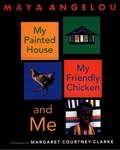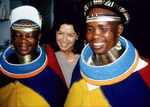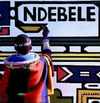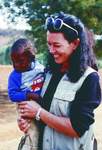

MARGARET
COURTNEY-CLARKE
BIOGRAPHY
Photojournalist Margaret Courtney-Clarke was born and
raised on a ranch on the edge of the Namib Desert in Namibia. Her playmates were
Africa’s children. They taught her to read the earth and the sky and to
understand the habits of wild animals in that particular corner of the world.
Because of her upbringing, Courtney-Clarke has an
innate love of the land and an instinctive understanding of those who live close
to the earth. And perhaps more importantly from the perspective of her work, her
African childhood also instilled in her a deep respect for the creative
manifestations of the people of Africa especially as reflected in their dress,
architecture and decoration.
As a child and adolescent, Courtney-Clarke was equally
at ease in the Victorian colonial home of her grandfather who was the head of
the civil service of South West Africa, (at that time a mandated territory of
the League of Nations) as she was in the mud homes of her African playmates. She
absorbed a cultural flexibility that has served her through the
30 years since
she left Namibia.
It is this cultural flexibility that makes her work
unique. Her photographic essays and books reflect an extraordinary blend of
sophisticated European and ancient African cultures.
With a diploma in art and photography from Natal
College in South Africa, Courtney-Clarke left Africa for Europe in 1972. Her
first stop in Europe was Italy where her love for art, architecture and
photography was nurtured and enriched. Soon after her arrival in Italy, she
started working at the renowned Obelisco Gallery in Rome that specialized in
contemporary art and photography. While there, she began to develop a career as
a photojournalist, focusing on art and architecture. Her photographs appeared in
many prestigious American, European and African publications. During this time
she also established a home in New York and obtained a B. A. in Photojournalism
from New York University.
Courtney-Clarke is an intensely practical person, for
all her absorption in aesthetics, and it is this quality that enabled her to
record in photographs the remote, seldom seen traditions of rural art, as well
as the elaborate urban achievements of European peoples.
In the 1981 volume, Cape Dutch Homesteads (Struik), she teamed up with South African
photographer David Goldblatt to memorialize the magnificent gabled homes unique
to the southern tip of Africa, living with the owners so that homes could be
seen in all lights and all aspects. Then, with this rare flexibility, she turned
an equally intense focus on the homes of the Ndebele people of Southern Africa.
Travelling thousand of miles to find the remote poverty-stricken villages where
the traditional mural painting still survived, she achieved a similar level of
trust and intimacy with the home-owners.
Her book Ndebele:
The Art of an African Tribe (Rizzoli
1986) has been acclaimed in the USA, in Europe, Japan and in Africa itself. This
book not only conveyed the glory of the work but also did what so few authors or
photographers of African art have ever done – it acknowledged the women who
were responsible for it. Courtney-Clarke gave these women personal recognition.
She lived with them while photographing them and became their friend. She
meticulously recorded their names and their art so that the book became not only
a tribute to the visual beauty but also – without heavy-handed anthropological
analysis – a tribute to a group of people who have endured ethnic, political
and educational neglect.
Her second book in the series on women and their art, African
Canvas (Rizzoli 1990), turns a spotlight of equal intensity on the women of
West Africa, recording their traditional mural art. Photographed over three
years, it called for an almost reckless dedication, leading Courtney-Clarke on
journey after journey, in remote reaches where few Western travelers have ever
penetrated. She endured hardship, disease and endless struggles with transport
and communication problems, to seek out the gems of this vanishing art. And she
did it with the same profound respect for the people involved that marked the Ndebele
book, waiting days and weeks and months to win their trust and be welcomed
into the intimacy of their homes and lifestyle.
In the third book of her trilogy on African women, IMAZIGHEN:
The Vanishing Traditions of Berber Women, (Clarkson Potter 1996)
Courtney-Clarke examines the difficult lives and remarkable arts of Berber women
as they yield to the pressures of the twentieth century.
These award-winning books have been translated into
French, German and Italian and have generated worldwide interest in these
vanishing arts. Her work has inspired films, including CBC and BBC documentaries
on her and her photography; fashion and fabric designs; porcelain designs; the
African village at Dallas Zoo and numerous other creative pieces.
Her photographs have been exhibited on five continents
and have been featured on the
covers of countless magazines – And her work has been acquired by private
collectors, Galleries and Museums.
In 1994 America’s favorite poet Maya Angelou joined
photojournalist Courtney-Clarke to introduce children and their cultures from
around the world in a series of juvenile books; My Painted House, My Friendly Chicken and Me (Clarkson Potter, 1994)
and Kofi and His Magic (Clarkson
Potter, 1996) are the first two titles in this series – both award winning
books.
Released in December 1999, Courtney-Clarke’s
long-awaited book Maya Angelou: The Poetry
of Living, offers a tribute through revealing portraits and interviews of
the Poet Laureate and friend who has influenced her life as well as the lives of
millions around the world.
For the past two years Courtney-Clarke has devoted her
time to the Ndebele Foundation, fundraising and building a Cultural Center for
Women and Children.
When she is not in the U.S. or travelling in Africa and
Europe, Courtney-Clarke retreats to her home in the country north of Rome.
Tel:
(0761) 28. 98. 73
Fax: (0761) 28. 79. 58
E-mail: mccphoto@iol.it












